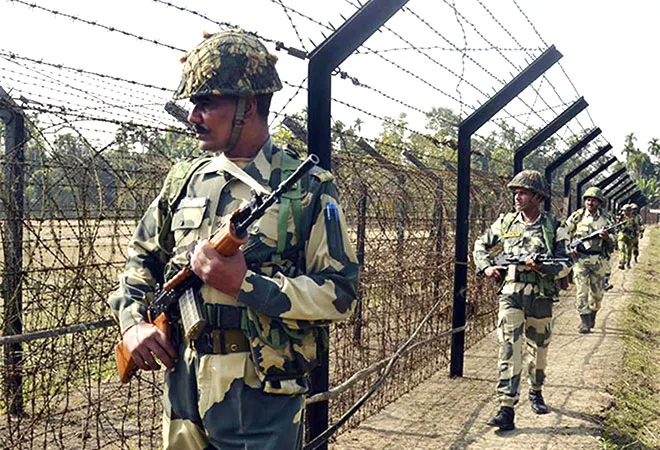On July 6, the Border Security Force (BSF) informed about the surge in cattle smuggling to Bangladesh due to the forthcoming Eid-ul Azha or the Qurbani Eid on July 31. The press release elaborated on the various techniques adopted by the smugglers for transporting the cattle. It also detailed the various cruelties inflicted by smugglers on the animals and warned that the consumption of such meat might be injurious to human health. Further, it flagged concerns about unemployed poor youths being lured into this network for meagre amounts of money. These youth face all the risk while kingpins of the racket earn billions of rupees while sitting in their safe havens.
Cattle smuggling between India and Bangladesh is worth nearly $1 billion annually. Every year, thousands of cattle are smuggled from India to Bangladesh, which ensures a significant supply of protein in that country. The smuggling increases exponentially during the Eid-ul Azha due to a rise in demand following the mass sacrifice of the cattle on this occasion.
The high price of cattle is a major push factor for cattle smuggling. A full-grown buffalo that costs Rs 50,000 in India is sold for nearly Rs 1,50,000 in Bangladesh and a bullock is sold for Rs 80,000. The margins make it lucrative for criminals to run this network by engaging poor unemployed youth, who work as peddlers for cattle to cross the border. The peddlers often fall prey to inter-gang rivalry or are caught by security forces.
Cattle smuggling causes deaths on the border, an irritant in the India-Bangladesh relations. It generates a feeling of ill-will towards India in Bangladesh. Interestingly, a majority of the people who die on the border are cattle smugglers, referred to as traders in Bangladesh media. Cattle smuggling also pose a serious challenge to BSF personnel. Many BSF personnel have been attacked during checks at the border — cattle smugglers have targeted around 16 BSF personnel in 2020. This cross-border smuggling must end so that people don’t get killed on the border.
Cattle smuggling causes deaths on the border, an irritant in the India-Bangladesh relations. It generates a feeling of ill-will towards India in Bangladesh
India has been using non-lethal weapons during patrols to reduce the incidents of death since 2010-11. This measure has helped to bring down the number of deaths substantially. For instance, the toll in 2009-18 was 294 people whereas about a thousand people were killed during 2001-09. The BSF claims they open fire only in self-defence, when they are attacked by criminals. However, attacks on the BSF have increased after the introduction of non-lethal weapons. More than 800 BSF personal have been attacked and injured by the smugglers till date.
Clearly, joint efforts from India and Bangladesh are necessary to end smuggling. While the border-management cooperation between the two countries has increased in the past few years, and many steps have been taken including a comprehensive border management plan to control illegal activities across the border, much more has to be done on the drawing board itself.
A major impediment to addressing the issue is that cattle smuggling is perceived differently in the two countries. India considers cattle smuggling as a criminal activity while it is not so in Bangladesh. Bangladesh has given a legal edifice to this as anybody can take these cattle by paying a fee to the customs authority. All one has to declare is that the cattle were found roaming near the boundary. This policy has helped Bangladesh to earn revenue and ensured an enhanced supply of protein.
A major impediment to addressing the issue is that cattle smuggling is perceived differently in the two countries. India considers cattle smuggling as a criminal activity while it is not so in Bangladesh
Besides the human cost, the illegal cattle trade has given a fillip to crimes like money laundering and gold smuggling because most of the payments are done through informal channels. It has helped in triggering trans-border criminal activities because such networks are also used for other kinds of smuggling. For instance, cattle smuggling has prevented the growth of the indigenous cattle industry in Bangladesh. The growth of the cattle industry could help the country not only enhance its meat industry but also facilitate the growth of export-oriented industries like processed meat and leather, a move that will contribute to diversifying Dhaka’s exports.
For India, the role of state agencies will be critical in curbing cattle smuggling. Much of the cattle travel long distances to arrive at the border. The forces at the border are only the last line of defence in controlling smuggling. If employment opportunities are generated in the bordering areas, youth will be discouraged from joining the smuggling network.
Needless to say, bilateral cooperation among various agencies is essential to eliminate the menace. Hopefully, a more technology-based vigil will be introduced soon at the borders. However, the trans-boundary mafia network will flourish as long as the bigwigs remain elusive.
This commentary originally appeared in Indian Express.
The views expressed above belong to the author(s). ORF research and analyses now available on Telegram! Click here to access our curated content — blogs, longforms and interviews.




 PREV
PREV


